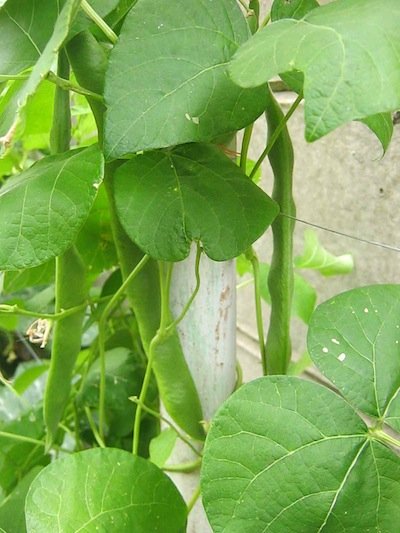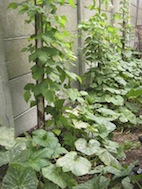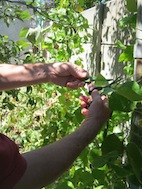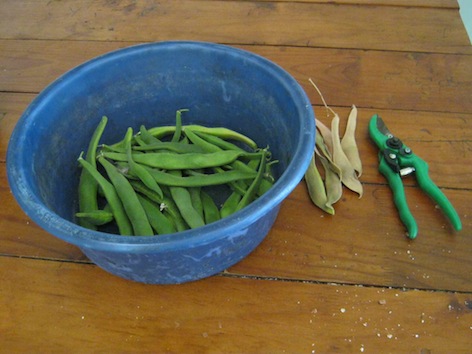Dear Reader, in this age of AI created content, please support with your goodwill someone who works harder to provide the human-made. Sign up at the top of the lefthand column or bottom of this page. You will receive my hand illustrated monthly newsletter RESTORE NATURE and access to the biodiversity garden design course as I write...and nothing else, I respect your time. I am also removing the advertizing as best I can as its become intrusive inappropriate and pays me nothing.
growing green beans is easy and the results are delicious

Beans are one of the easiest vegetables to grow. Growing green beans is a must in the garden. The variety of climbing beans we used was Climbing White Emergo, and it did very well in our soil which is sandy with lots of added Nitrogen rich compost and some vermicompost. These beans thus seem to tolerate Nitrogen rich and quite dry conditions.
Because beans harvest their own Nitrogen, or ‘fix’ Nitrogen, in bacterial nodules on their roots, and have strong tap roots, it is thought best to plant them direct in the soil. However, our climate is so dry it is hard to keep the soil moisture level stable enough for germination. We did the unthinkable and sowed the bean seeds in six packs, and transplanted them when they had two or four heart shaped adult leaves, not just the small oval seed leaves or cotyledon. They thrived, as you can see.
growing green beans is a pleasure

We grew them on a trellis with verticals made from rough second hand steel reinforcing bars, about one centimeter thick and cut to length at the dealers, and with horizontals made of thin wire spanned between the poles. I set up the trellising system first then prepared the beds and planted out a few weeks later after the compost had been aired for a while. The beans wound their own way up the terrace without my assistance except at first, when they needed just a little guidance as the first wire was rather high and they lay horizontal across the ground winding around whatever they could find to hold onto.
We watered them daily at about six in the evening as shadow began to fall across the back yard. We use watering cans and water that has stood for a day to let the chlorine from the mains water evaporate.

growing green beans is nothing compared to the pleasure of harvesting them
The beans have pretty white flowers and the fruit are large, flat, slightly furry and have a delicious flavor. Steve harvested them with scissors to prevent damage to the vines. Even when harvested quite late, the fat white beans in the pods are creamy and fresh tasting. The later harvested beans had quite a bit of fibre, or string in them, so we suggest cooking them first and then destringing them if you don’t like chewing on the vegetable fibre and having to spit it out. As I ate I could hear my father’s voice joking about “stroings boins” (string beans in his version of an Australian accent), and there really is a reason for their name. Steve used them for an absolutely delicious Boontjie Bredie or traditional South African bean stew.

We have kept some of the biggest most perfect beans for seed collection. You can see the dry one’s we collected, which were already dry, but mostly malformed. The biggest and most perfect beans are still ripening on the vine. As I’ve learned from my permaculture teacher, who is an expert on organic seed saving, most seeds must be really really ripe and ripened on the plant to be fertile. I hope they are viable and we'll be growing green beans for free next year. This year's harvest was well worth it.
home page with links to lots of useful information on home gardening
vegetable gardening the natural and low cost way
Restore Nature Newsletter
I've been writing for four years now and I would love to hear from you
Please let me know if you have any questions, comments or stories to share on gardening, permaculture, regenerative agriculture, food forests, natural gardening, do nothing gardening, observations about pests and diseases, foraging, dealing with and using weeds constructively, composting and going offgrid.
SEARCH
Order the Kindle E-book for the SPECIAL PRICE of only
Prices valid till 30.09.2023
Recent Articles
-
garden for life is a blog about saving the earth one garden at a time
Apr 18, 25 01:18 PM
The garden for life blog has short articles on gardening for biodiversity with native plants and regenerating soil for climate amelioration and nutritious food -
Cape Flats Sand Fynbos, Cape Town's most endangered native vegetation!
Apr 18, 25 10:36 AM
Cape Flats Sand Fynbos, a vegetation type found in the super diverse Cape Fynbos region is threatened by Cape Town's urban development and invasive alien plants -
Geography Research Task
Jan 31, 25 11:37 PM
To whom it may concern My name is Tanyaradzwa Madziwa and I am a matric student at Springfield Convent School. As part of our geography syllabus for this
"How to start a profitable worm business on a shoestring budget
Order a printed copy from "Amazon" at the SPECIAL PRICE of only
or a digital version from the "Kindle" store at the SPECIAL PRICE of only
Prices valid till 30.09.2023







